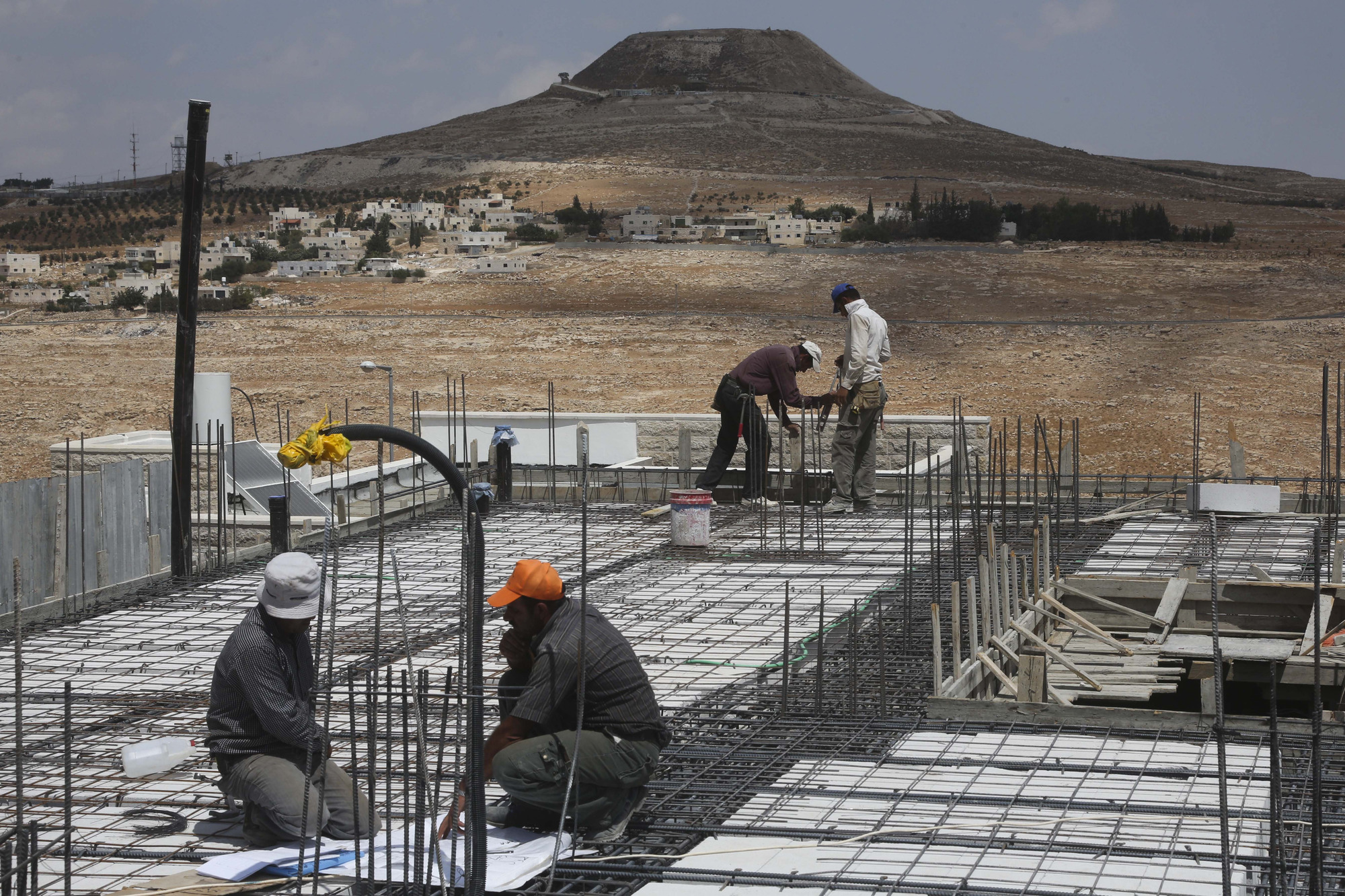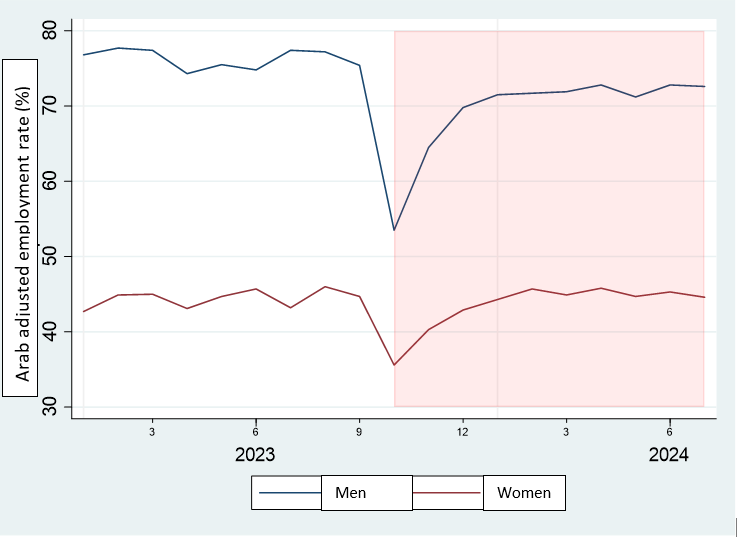The Impact of the War on Israel's Arab Population in the Labor Market
An analysis of the effects of the war on employment within Israel's Arab population.

Picture from Flash90
This report analyzes the effects of the war on employment within Israel's Arab population (Arab citizens of Israel), based on the monthly Labor Force Survey data from the Central Bureau of Statistics. The report compares three different periods: before the war, the start of the war, and late in the war—that is, a comparison of the situation at the beginning of 2023 to the initial months of the war and to the most recent analyzable data, which is from July 2024.
Key findings:
- As of July 2024, the war has had a significant and ongoing impact on Arab workers.
- Over 22,000 Arab men of working age who were employed before the war had not returned to the labor market by July 2024. Employment rates for Arab women have returned to their original levels.
- In the construction sector alone, approximately 3,300 Arab workers who were employed before the war had not returned to the labor market by July. Additionally, approximately 4,000 Arabs in the hospitality, food services, and financial services sectors have not returned either.
- At the beginning of the war, there was a noticeable impact due to Arab men's fear of working among Jews: 28% of men working in Jewish communities stopped working in October 2023, compared to 22% of men working in Arab communities.
- The findings may indicate a potential widening of gaps within Arab society itself—between sectors characterized by lower education levels (such as construction, hospitality, and food services) and other sectors, as well as between men and women. Additionally, there may be an increased burden on the welfare authorities and young households, due to the long-term withdrawal of older adults from employment.
Before the war, the adjusted employment rate[1] for both Arab men and women showed a consistent upward trend, reaching a peak of 77.7% among Arab men and 45% among Arab women at the beginning of 2023 (within the main working age range, see Figure 1). This rate was significantly affected upon the outbreak of the war, dropping to 53.5% for men and 35.6% for women in October 2023 – almost a third of Arab men who were employed before the war were not working in October 2023. The adjusted employment rate began to recover as the economy shifted to a wartime routine at the end of 2023. Among women, the rate returned to pre-war levels (45%) and even surpassed it from February 2024 onward. However, by July 2024, the adjusted employment rate for Arab men had not fully recovered: despite a relative increase from the low point at the start of the war, it stabilized at around 72% since early 2024. This indicates that approximately 5.7% of Arab men aged 25-64—approximately 22,350 Arab men—were employed before the war but had not returned to work by July 2024.
Figure 1: Adjusted Employment Rate of the Arab Population, Ages 25-64, by Gender

At the beginning of the war, the decline in employment among Arabs was primarily due to temporary absences: the rate of those absent from work for "other reasons" within the labor force (which typically stands at nearly 0% across all populations in normal times) surged to 15-16% in October 2023 among both Arab men and women (compared to approximately 10% among Haredi Jews and approximately 6% among non-Haredi Jews, see Figure 2). According to an analysis published by the Bank of Israel,[2] this "other reason" at the beginning of the war essentially reflects a fear of going to work. This fear was prevalent across all populations at the war's onset but was particularly severe among the Arab population, who not only feared the war itself but also had concerns about interactions with Jews and the potential for acts of revenge. Although this effect was significant in October, it completely disappeared in the following months across all groups, with the rate of temporary absences for "other reasons" returning to 0% by July 2024.
In other words, as time passed since the outbreak of the war, the impact still visible on Arab employment has become consistent and ongoing. The steady decline observed in the employment of Arab men is not due to temporary absences; rather, there is a persistent and significant portion of Arab workers who have exited the workforce permanently, not just temporarily.
In order to examine the issue of concern about interaction with Jews, we analyzed the adjusted employment rate of Arabs working within Jewish localities compared to those working in Arab localities.[3] Looking at the overall Arab population, it is evident that the decline in the adjusted employment rate was indeed slightly higher among those working in Jewish localities—25% of those working in Jewish localities stopped working in October 2023, compared to 21% of those working in Arab localities. This difference may partly stem from the fear that Arab workers employed in Jewish localities felt about entering and being seen in such areas at the beginning of the war, or due to restrictions imposed on the entry of Arabs into Jewish localities (as was reported in the media on several occasions at the beginning of the war).
Figure 2: Reasons for absence from work, ages 25-64, by population group

By industry classification (Figure 3), the significant employment impact on the Arab population at the start of the war was concentrated in the hospitality and food services sectors (the percentage of individuals classified under this sector who were employed dropped by approximately 34 percentage points, from an average of 90.6% in 2023 before the war, to a low of 57%)[1]; healthcare and welfare (a decrease of approximately 31 percentage points, from 90.9% to 60.2%); and agriculture (a decrease of 23 percentage points, from 86.9% to 63.8%).
In the construction sector, this rate dropped from 90.8% to 65.2%, a decline of approximately 26 percentage points. This decrease was driven by a general reduction in industry activity due to the closure of a significant number of construction sites across the country, resulting from the drastic drop in the number of Palestinian workers who came from the West Bank prior to the war, and the departure of many foreign workers (mainly from China). There were also security concerns regarding the employment of Arab men in Jewish residential areas.
However, toward mid-2024, the situation looked different, with employment rates in almost every sector returning to levels observed before the war. The sectors that remained with relatively low employment rates among Arabs who are classified under them were hospitality and food services (82% in April-July 2024)[2] and financial services (85.2%). In numerical terms, this accounts for nearly 4,000 Arab workers in these sectors who were employed before the war but are currently either unemployed or on furlough.[3]
In the construction sector, the employment rate among Arabs classified under this sector did recover to some extent; however, it still stood at around 87% during these months, a decrease of approximately 4 percentage points compared to pre-war levels. Since this sector employs a large number of Arab workers, this rate equates to approximately 3,300 Arab workers employed before the war but currently not working.
Figure 3: Employment rate of Arabs classified according to economic sectors, ages 25-64, by sector

[1] The rate of those actually working out of the total population: includes all employed individuals, excluding those absent from work for economic reasons (typically due to furlough), excluding those absent for other reasons, and excluding those on military reserve duty. This rate is almost identical to the general employment rate in routine times but is significantly affected during periods of unpaid leave, such as during the COVID-19 pandemic or war. Additionally, at the beginning of the war, absenteeism for other reasons was very common due to concerns about leaving the house, particularly among the Arab population. The adjusted employment rate serves as the effective rate for Arabs compared to other populations during the war, and therefore, it will be used here.
[2] Bank of Israel Report 2023
[3] Employment rates are close to 100% under normal conditions when analyzed by type of employment locality. This is because information on the locality where an individual works is only available for those who are currently or were recently employed.
[4] Employment rates measured by industry are significantly higher than those for the general population because industry affiliation information is only available for those who are currently in the workforce or have been in recent years, typically nearing 100% in normal circumstances. Those who have not worked recently, or never worked at all, cannot be classified into any specific industry and are therefore not included in the denominator.
[5] An average over several months was selected in order to, on one hand, reflect the most current situation and, on the other hand, avoid seasonal effects.
[6] 2,489 workers in the hospitality and food services sector and 1,465 workers in the financial services sector.
